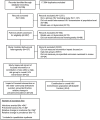Impact of high-risk sex and focused interventions in heterosexual HIV epidemics: a systematic review of mathematical models
- PMID: 23226357
- PMCID: PMC3511305
- DOI: 10.1371/journal.pone.0050691
Impact of high-risk sex and focused interventions in heterosexual HIV epidemics: a systematic review of mathematical models
Abstract
Background: The core-group theory of sexually transmitted infections suggests that targeting prevention to high-risk groups (HRG) could be very effective. We aimed to quantify the contribution of heterosexual HRGs and the potential impact of focused interventions to HIV transmission in the wider community.
Methods: We systematically identified studies published between 1980 and 2011. Studies were included if they used dynamical models of heterosexual HIV transmission, incorporated behavioural heterogeneity in risk, and provided at least one of the following primary estimates in the wider community (a) the population attributable fraction (PAF) of HIV infections due to HRGs, or (b) the number per capita or fraction of HIV infections averted, or change in HIV prevalence/incidence due to focused interventions.
Findings: Of 267 selected articles, 22 were included. Four studies measured the PAF, and 20 studies measured intervention impact across 265 scenarios. In low-prevalence epidemics (≤5% HIV prevalence), the estimated impact of sex-worker interventions in the absence of risk compensation included: 6-100% infections averted; 0.9-6.2 HIV infections averted per 100,000 adults; 11-94% and 4-47% relative reduction in prevalence and incidence respectively. In high-prevalence epidemics (>5% HIV prevalence), sex-worker interventions were estimated to avert 6.8-40% of HIV infections and up to 564 HIV infections per 100,000 adults, and reduce HIV prevalence and incidence by 13-27% and 2-14% respectively. In both types of epidemics, greater heterogeneity in HIV risk was associated with a larger impact on the fraction of HIV infections averted and relative reduction in HIV incidence.
Conclusion: Focused interventions, as estimated by mathematical models, have the potential to reduce HIV transmission in the wider community across low- and high-prevalence regions. However, considerable variability exists in estimated impact, suggesting that a targeted approach to HIV prevention should be tailored to local epidemiological context.
Conflict of interest statement
Figures


References
-
- Yorke JA, Hethcote HW, Nold A (1978) Dynamics and control of transmission of gonorrhea. Sex Transm Dis 5: 51–56. - PubMed
-
- Wasserheit JN, Aral SO (1996) The dynamic topology of sexually transmitted disease epidemics: implications for prevention strategies. J Infect Dis 174: S201–S213. - PubMed
-
- Hethcote HW, Yorke JA, Nold A (1982) Gonorrhea modeling - a comparison of control methods. Math Biosci 58: 93–109.
-
- Anderson RM, May RM (1991) Infectious diseases of humans: dynamics and control. Oxford: Oxford University Press.
-
- Moses S, Blanchard JF, Kang H, Emmanuel F, Reza Paul S, et al... (2006) AIDS in south Asia: understanding and responding to a heterogenous epidemic. Washington: The World Bank.
Publication types
MeSH terms
Grants and funding
LinkOut - more resources
Full Text Sources
Other Literature Sources
Medical
Miscellaneous

